
Children will watch the video to see how things have changed over time.
- Subject:
- Social Studies
- Material Type:
- Activity/Lab
- Lesson
- Lesson Plan
- Author:
- Utah Lesson Plans
- Date Added:
- 10/24/2022

Children will watch the video to see how things have changed over time.

As a Google Admin, learn how to reset passwords for users.
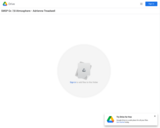
Students will explore changes in Earth's atmosphere over the past few centuries, then design, build, and analyze a structure that control internal temperature without using additional energy.

This nearpod lesson is a great lesson to use to teach the difference between physical and chemical changes in matter and properties. It provides many different student activities that are beneficial for learning and informal assessments. This lesson aligns to the Utah State Common Core Science Standards for grade 5.


Students will learn about their state as they collect and organize business information using State Facts for Students, a U.S. Census Bureau data tool. Students have the opportunity to examine data about kids their age, as well as a variety of other facts selected to appeal to young students. Students will create a bar graph to represent how the numbers of selected business types have changed between 2010 and 2021.

Thumbnail Image Credit: Antelope Canyon, by Meckimac, Creative Commons Attribution-Share Alike 3.0, Navajo Tribal Park, Arizona, USA.Students will learn about the changes in the earth's surface and and how they occur by going on virtual and real fieldtrips, discussing in groups, and sharing with the class. They will showcase their learning by creating a book with photographs and descriptions.

In this video adapted from the Arctic Athabaskan Council, learn how warmer temperatures in the Arctic are transforming the landscape, triggering a host of effects such as permafrost thawing and insect infestations.

This lesson plan addresses the Essential Question: How has lower Manhattan changed over time, with a focus on the eventual creation of the Twin Towers. It was created by the 9/11 Museum, and its main focus is the Twin Towers. It analyzed New Amsterdam, the creation of NYC, and then the creation of the Twin Towers. It uses primary sources to show the Twin Towers and their relationship with New Amsterdam.
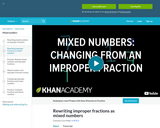
This lesson reviews how to change an improper fraction to a mixed number.

This activity is designed to accompany the contextual essay “A Changing of the Guard: Traditionalist, Feminist, and the New Face of Women in Congress, 1955–1976,” from the Women in Congress website, history.house.gov/exhibition-and-publications/wic/women-in-congress/. Students have the opportunity to learn more about the women who served in Congress from 1955 to 1976. Students are encouraged to analyze the role women Representatives and Senators played in Congress during this era, as well as the ways in which they may have changed the institution.

In this English Journal article, Chanski and Ellis discuss a teacher inquiry project that took place in an AP English class where the teacher supported students in learning to give meaningful peer evaluation to each other’s writing. They describe strategies that make the experience meaningful for student writers.
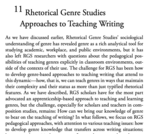
The book in its whole provides a thorough and accessible approach to understanding genre and its application in classrooms. Chapter 11 explains applications to teaching.
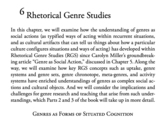
The book in its whole provides a thorough and accessible approach to understanding genre and its application in classrooms. Chapter 6 focuses on the rhetorical understanding of genre.
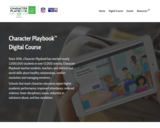
An NFL and United Way-sponsored program that teaches middle school students about cultivating and maintaining healthy relationships in the game, in the classroom, and in our everyday lives.
This set of lessons extends over several weeks and incorporates all acts of Arthur Miller's play, The Crucible. Students will closely read The Crucible. Students will cite textual evidence and make interpretations about character development.Students will combine the textual evidence with their interpretations and write interpretive statements. In the culminating activity, students will write a character analysis.

This is a lesson plan is meant to assist in teaching and assessing students' ability to identify character development, types, and changes. This resource can be modified to fit a novel unit study, short stories, or plays. The resource is intended to be used as a digital element in an in-person class but can be modified to fit other class types and modalities.Cover image: Photo by NeONBRAND on Unsplash

Create your own character chatbot!
Sharing quality literature provides the teacher with great opportunities for the class to discuss the interactions and feelings of people. It also allows the students to make connections based on their own feelings and experiences.
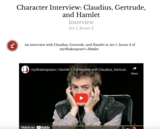
An interview with Claudius, Gertrude, and Hamlet in Act 1, Scene 2 of myShakespeare's Hamlet. This video is meant to be used in conjunction with the interactive play script on myShakespeare.com.